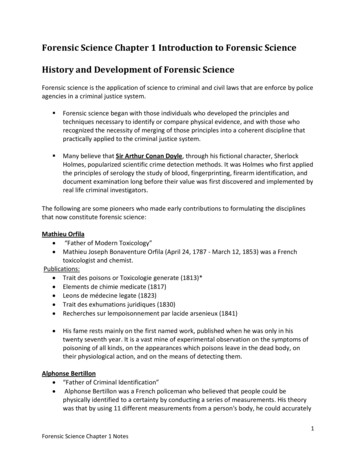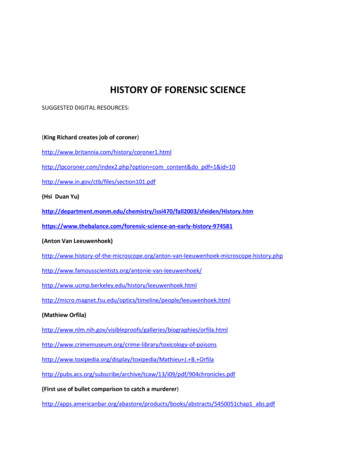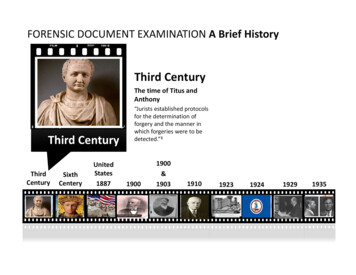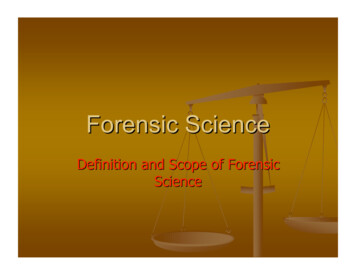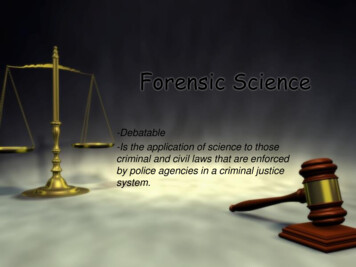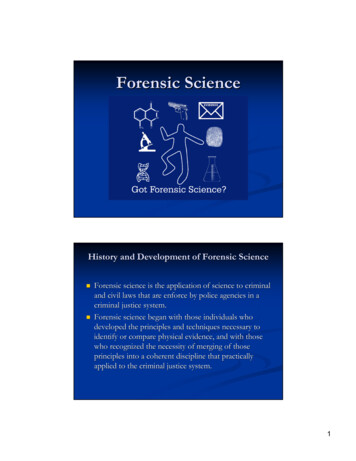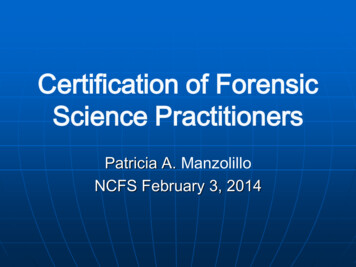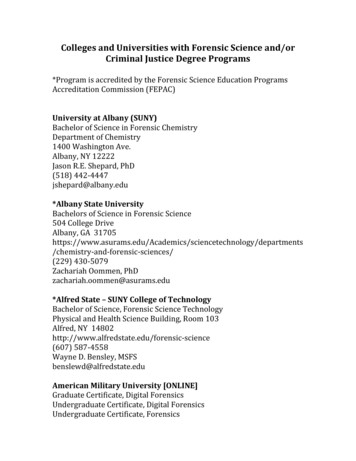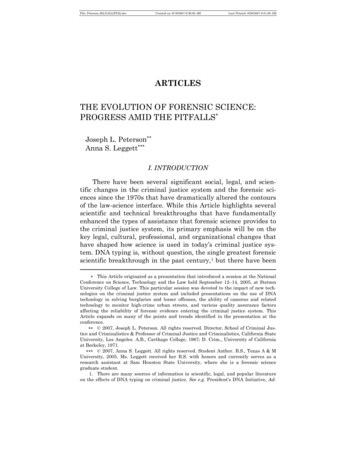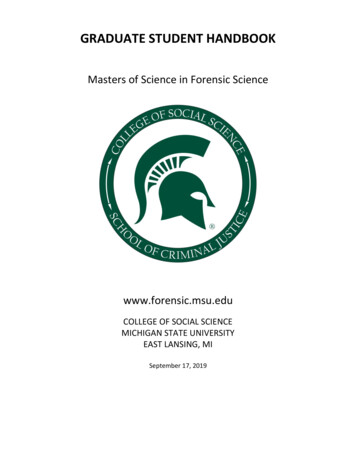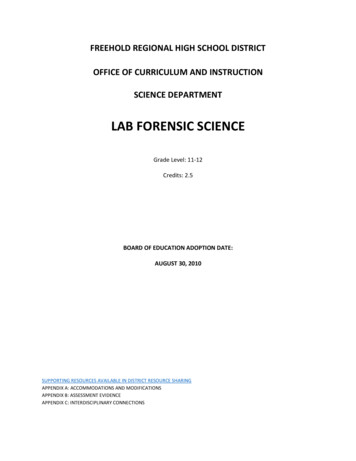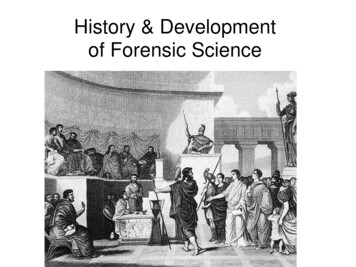
Transcription
History & Developmentof Forensic ScienceForensic Science
Students will learn: How a crime lab works The growth and development of forensicscience through history Federal rules of evidence, including the Fryestandard and the Daubert ruling Basic types of law in the criminal justicesystemStudents will be able to: Describe how the scientific method is used tosolve forensic problems Describe different jobs done by forensicscientists and the experts they consult.
When in Rome “Forensic” comes from the Latin word “forensis”meaning forum. During the time of the Romans, a criminal chargemeant presenting the case before the public. Both the person accused of the crime & theaccuser would give speeches based on their sideof the story. The individual with the best argument woulddetermine the outcome of the case.
First Known Forensic Science 3rd Century China - A wife poisoned her husband andburned his body. The coroner noted no ash inside hismouth and simulated the crime with dead & live pigs.The dead pig had no ash and the live pig did have ashin its mouth. The Wife confessed when shown theevidence. Chinese first to see potential in fingerprints.
Murders at the Mansion August 20, 1989, Lyle Menendez, 21, &his brother Erik Menendez, 18, wentout for the evening. When they returned, they found thattheir parents, Jose and Kitty, had beenshot and killed in the living room. At 11:47 p.m. Lyle called 911. Thepolice arrived shortly afterward. Therewas no evidence of forced entry, andnothing had been stolen from thehome— an indication Jose and Kittylikely knew their attackers. A witness told police she had seen twomen enter the home at around 10:00p.m. The brothers were questioned atthe scene, but they were notconsidered suspects. No gunshotresidue tests were administered.
http://thedebbiedaily.com/?page id 1999
http://thedebbiedaily.com/?page id 1999
August 28, the brothers began cashingin on their 650,000 life insurancepolicy. Jose and Kitty had owed money ontheir mortgage and several otherloans. After those had been paid, thebrothers were left with a totalinheritance of approximately 2million. By the end of the year, they had spentmore than 1 million. This behaviordrew suspicion from police. The brothers were arrested in March1990. With little physical evidence, theinvestigators were hoping to find a linkbetween the brothers and the gunsused in the killings.
Investigators searched the firearmsrecords of a Big 5 store anduncovered the sale of two shotgunson August 18, 1989, to DonovanGoodreau of San Diego. Goodreau had an alibi for August 18and August 20, and the signature forthe firearms did not match his. A court order was issued forhandwriting samples from Lyle andErik. Erik refused to provide ahandwriting sample. On December 8, 1992, theMenendez brothers were indicted bythe Los Angeles Grand Jury. The trial began on July 20, 1993.
The defense admitted the brothers killed their parents; they arguedthat the brothers had been sexually, physically, and emotionallyabused for years. Under California law, jurors had to believe the brothers feared fortheir lives in order to acquit them. The case resulted in a mistrial. A second trial in 1995 resulted in guilty verdicts for Lyle and Erik. They were convicted of first-degree murder and conspiracy tocommit murder. On April 17, 1996, the brothers were sentenced to life in prisonwithout the possibility of parole.Inheritance Killers - Erik & Lyle Menendez:https://www.youtube.com/watch?v lofyBKoKnasLiving next door to the killer Menendez brothers:https://www.youtube.com/watch?v 5Inb6zCb5Ns
Mathieu Orfila(1787-1853) “Father of Toxicology” Wrote about the detection of poisons &their effects on animals.
Alphonse Bertillon “Father of Anthropometry” Developed a system to distinguish one individualperson from another based on certain bodymeasurements.
Anthropometry
Francis Galton (1822-1911) “Father of Fingerprinting” Developed fingerprinting as a way to uniquelyidentify individuals.
James MarshScottish Chemist First to introduce chemical evidence of arsenicin a body during a trial in 1839.
Leone Lattes(1887-1954) “Father of Bloodstain Identification” He developed a procedure for determiningthe blood type (A, B, AB, or O) of a driedblood stain.
Calvin Goddard(1891-1955) “Father of Ballistics” Developed the technique to examinebullets, using a comparisonmicroscope, to determine whether ornot a particular gun fired the bullets.
Albert Osborn(1858-1946) “Father of Document Examination” His work led to the acceptance ofdocuments as scientific evidence by thecourts.
Walter McCrone(1916-2002) “Father of Microscopic Forensics” He developed & applied his microscopetechniques to examine evidence in countlesscourt cases.
Edmond Locard (1877-1966) Used thescientific method incriminal investigation.Background wasmedicine and law.Father ofcriminalistics. Built the world’s firstforensics lab in Francein 1910
The Locard Exchange Principle Locard Exchange Principlestates: Whenever two objects comeinto contact with each other,there is always a transfer ofmaterial.
J. Edgar Hoover “Father of the FBI” - Director of Federal Bureauof Investigation during the 1930’s Hoover's leadership spanned 48 yrs & 8 presidentialadministrations. His reign covered Prohibition, the GreatDepression, WWII, the Korean War, the Cold War, & theVietnam War. He organized a national laboratory to offer forensicservices to all law enforcement agencies in the U.S. VERY CONTROVERSIAL– He exceeded & abused his authority with unjustifiedinvestigations & illegal wiretaps based on political beliefs ratherthan suspected criminal activity– FBI directors are now limited to 10-year terms
Sir Alec Jeffreys First to develop a DNA profile (DNAfingerprint) 1984
The Scientific Method Forensic science beginsat the crime scene. Forensic scientists relyon the SCIENTIFICMETHOD. Scientific Method: is aseries of logical stepsused to solve aproblem.
Steps in the Scientific Method Identify the Problem:crime has been discovered& police arrive at the scene. Do Background Research:Observe and collect thephysical evidence found atthe crime scene. (done bythe police & investigators)
Construct Hypothesis: (police)– hypothesis is an attempt toanswer the followingquestions: what happened,how did it happen, andwhen did it happen?– The crime-sceneinvestigator does not forma hypothesis. Instead, he orshe sends the evidence tothe crime lab for furtheranalysis. Establish a set of Procedures:send the physical evidencecollected to the lab for testing.Ex. The hair removed from acrime scene is tested to revealcolor, texture, and shape.
Analyze results:– If the toxicology reportshows no use of drugs &there is no follicular tag(no nuclear DNA), it meansthat the hair will mostlikely not be linked toanyone. The tests can helpinvestigators reduce thenumber of potentialsuspects. Draw conclusion:– After all of the physicalevidence has beenprocessed and evaluated,a conclusion is drawn. If asuspect can be linked to acrime, then the suspect isapprehended.
The Crime Scene Investigation (CSI) Team Team of legal and scientific experts who worktogether to process a crime scene and evaluate theevidence. Divided into a field investigative unit & crime labscientists.
The Crime Scene Investigation (CSI) Police officers are usually the first toarrive at the scene.– They secure the scene andprovide first aid to anyone whoneeds it. Crime-scene investigators– record details about the crimescene and collect physicalevidence.– include photographers, sketchartists, and evidence collectors. Medical examiners are called in whenthere is a death.
Crime Labs Evidence collected at the scene is sent to the crime lab for analysis. Forensic scientists at the crime lab:– specialize in fields such as chemistry, toxicology, pathology, and firearms.– remain completely neutral in their analysis.– do not form a hypothesis or draw conclusions about guilt or innocence. Information gathered from chemical and physical tests can be used:– to establish a timeline of events.– may corroborate a witness’s statement. Poor communication:– could lead to critical mistakes.– Could put the entire process is in jeopardy. Ex, if the evidence is not collected properly, investigators in the crime lab may notmake the correct analysis.
PROCESSING A CRIME SCENE The first authorizedpersonnel to arrive:– must secure the scene,usually with crime-scenetape,– move unauthorized peopleaway from the area.– Help someone in need ofmedical attention beforedoing anything else.– detain and questionedpeople around the area(depending on thesituation).
Before any evidence iscollected:– Sketch & photograph the entirescene.– Evidence must be leftundisturbed in its originallocation. If circumstances warrant movingthe evidence: ex. to tend to aninjured victim, it must be notedin the records. Measurements of the crimescene and locations of items ofevidence must be documented. After the crime scene and theevidence have beenphotographed,– the field investigator will beginto collect and package thephysical evidence.
The size and location of a crimescene will determine thesearch method used: Zone—building or otherstructure—homicide, homeinvasion, robbery, sexualassault, etc. Spiral—large area, nobarriers—open field—kidnapping, homicide Line search—large arealooking for a large object in asingle direction—site of aplane crash Grid—large area looking for alarge object in twodirections—arsoninvestigation
EVIDENCE The analysis of physical evidence and thepresentation of findings in court are the mostpowerful resources available to a prosecutor. Often, the physical evidence presented at courtcan be the determining factor of guilt orinnocence of the suspect. Two basic types of evidence exist—– Testimonial– Physical
Testimonial evidence gathered by lawenforcement or CSI witness testimony usedto build a timeline ofevents or to confirm asuspect’s whereabouts.
Physical evidence material collected orobserved at a crime scenethat could link potentialsuspects to a crime. can range in size from adrop of blood to largeobjects, such as furnitureor a door.– Ex. a document, hair,fibers, fingerprints, soil,and blood.
Each piece of evidencecollected must be packagedseparately to avoid crosscontamination– Ex. bloody clothing is firstair dried and then packagedin a paper bag.– A pool of blood will beswabbed. The swab is thenair dried and placed in aplastic vile. blood evidence must be driedprior to storage in order toprevent mold and bacterialgrowth.
chain of custody provides documentation of everyperson who has come into contact withthe evidence. (acts as a “paper trail.” ) Established once an item of evidence iscollected. The name recorded are:– the person who collected and packagedthe evidence is recorded.– each person who has handled, analyzed,or transported the evidence is recorded. Every time the evidence is opened, anew seal is formed. The person whohandled the evidence then signs overthe new seal. Demonstrates to the courts that theevidence that is being presented at trialis free of contamination, alteration, orsubstitution.
Trace Evidence very small amounts ofcertain physical evidenceare found at the crimescene.– include gunshot residue, atiny amount of blood, asingle hair, or paint. Remember Locard’sexchange principle: contactbetween a victim and asuspect or between asuspect and a locationresults in a transfer ofmaterial. In an effort to prevent contaminating ordestroying the evidence, fieldinvestigators do not remove traceevidence, if possible, from the objectthat bears it. Ex. a soda can may becollected and sent to the crime lab fortesting because fingerprints were visibleon the can. Additional tests might reveallip prints and saliva on the rim anddrugs dissolved inside the can.
Evidence Submission Form: Used to submit evidence forlab processing and analysis On the form:– Items of evidence are listed witha brief description of each item– testing procedure requested.
Evidence may also be compared toknown samples to determine thekind of weapon or to build atimeline of events. Reference samples- samples from aknown source; used as a basis ofcomparison. Ex. a white powder isfound at a crime scene.– The white powder is identified ascocaine mixed with some inorganicsubstances and there isn’t enoughinformation to link the substance to asuspect.– If a suspect is apprehended with tracesof white powder in his pocket, thepowder can be compared to thecocaine mixture found at the crimescene.– If the two samples are consistent, thesuspect may be arrested.
If the evidence isdetermined to possessclass characteristics:– common to a group ofobjects or persons– it cannot be directlyconnected to oneperson or source.– Ex. blood type, fibers,and paint.
When evidence exhibitsindividual characteristics:– evidence—can beidentified with a particularperson or a single source– Ex. nuclear DNA (hairfollicle, blood cells, orsemen)– Tool marks and fingerprintsbecause of the uniquenessof their patterns.The large piece of glass fitsexactly to the bottle; it isindividual evidence.
Class vs. Individual EvidenceWhich examples do you think could beindividual evidence?
Federal Rules of Evidence(Admissibility of Evidence)FRYE V. UNITED STATES In 1923, in the case of Frye v. United States,James Frye was convicted of second-degreemurder. He had confessed to the murder, but laterretracted his confession. Frye appealed his conviction on the grounds thatthe lie detector test he had taken proved he wastelling the truth. He also had an expert prepared to explain thescientific methods used to determine theoutcome of his lie detector test.
Federal Rules of Evidence(Admissibility of Evidence)FRYE V. U
Albert Osborn (1858-1946) “Father of Document Examination” His work led to the acceptance of documents as scientific evidence by the courts. Walter McCrone (1916-2002) “Father of Microscopic Forensics” He developed & applied his microscope techniques to examine evidence in countless court cases. Edmond Locard (1877-1966) Used the scientific method in criminal .
